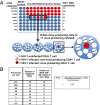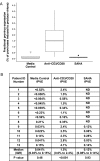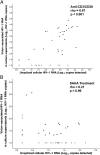Quantification of HIV-1 latency reversal in resting CD4+ T cells from patients on suppressive antiretroviral therapy
- PMID: 24706775
- PMCID: PMC4024870
- DOI: 10.1073/pnas.1402873111
Quantification of HIV-1 latency reversal in resting CD4+ T cells from patients on suppressive antiretroviral therapy
Abstract
Reversal of proviral latency is being pursued as a curative strategy for HIV-1 infection. Recent clinical studies of in vivo administration of the histone deacetylase inhibitor suberoylanilide hydroxamic acid (SAHA; vorinostat) show increases in unspliced cellular HIV-1 RNA levels in resting CD4(+) T cells. A critical unknown, however, is the proportion of latent proviruses that can be transcriptionally reactivated by SAHA or T-cell activation. In this study, we quantified the fraction of HIV-1 proviruses in resting CD4(+) T cells from patients on suppressive antiretroviral therapy that were reactivated ex vivo with SAHA or antibodies to CD3/CD28. At concentrations of SAHA achieved clinically, only 0.079% of proviruses in resting CD4(+) T cells were reactivated to produce virions, compared with 1.5% of proviruses in cells treated with anti-CD3/CD28 antibodies after correcting for spontaneous virion production in the medium control. A significant positive correlation (ρ = 0.67, P < 0.001) was found between levels of virions in the supernatant and unspliced cellular HIV-1 RNA following anti-CD3/CD28 treatment, but not following SAHA treatment (ρ = 0.21, P = 0.99). These results reveal that the majority of HIV-1 proviruses are not reactivated by current therapeutic approaches and that more effective means of reversing proviral latency will likely be required to deplete HIV-1 reservoirs.
Keywords: HIV-1 cure; HIV-1 eradication; HIV-1 persistence; fractional provirus expression.
Conflict of interest statement
Conflict of interest statement: J.W.M. is a consultant for Gilead Sciences and RFS Pharma and owns shares of RFS Pharma.
Figures



Comment in
-
Measuring reversal of HIV-1 latency ex vivo using cells from infected individuals.Proc Natl Acad Sci U S A. 2014 May 13;111(19):6860-1. doi: 10.1073/pnas.1405194111. Epub 2014 May 5. Proc Natl Acad Sci U S A. 2014. PMID: 24799684 Free PMC article. No abstract available.
References
-
- Chun TW, et al. Quantification of latent tissue reservoirs and total body viral load in HIV-1 infection. Nature. 1997;387(6629):183–188. - PubMed
-
- Wong JK, et al. Recovery of replication-competent HIV despite prolonged suppression of plasma viremia. Science. 1997;278(5341):1291–1295. - PubMed
-
- Finzi D, et al. Latent infection of CD4+ T cells provides a mechanism for lifelong persistence of HIV-1, even in patients on effective combination therapy. Nat Med. 1999;5(5):512–517. - PubMed
-
- Siliciano JD, et al. Long-term follow-up studies confirm the stability of the latent reservoir for HIV-1 in resting CD4+ T cells. Nat Med. 2003;9(6):727–728. - PubMed
Publication types
MeSH terms
Substances
Grants and funding
LinkOut - more resources
Full Text Sources
Other Literature Sources
Medical
Research Materials

